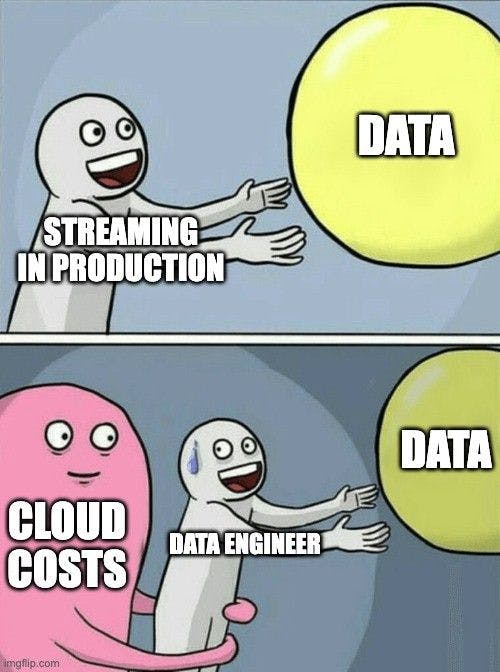Using the New Spring Boot - Apache Pulsar Integration
Code: https://github.com/tspannhw/spring-pulsar-airquality
New Spring Module for Apache Pulsar
This uses https://github.com/spring-projects-experimental/spring-pulsar
This is how we can easily utilize the new Spring library for Pulsar applications.
Setup
- Visual Code with Spring Boot 3.0.0. & Java JDK 17
- Apache Pulsar Version 2.10.1 works with 2.9.1+
- Set an environment variable with your API key code from AirNow
- Point to your Apache Pulsar cluster, if you are using StreamNative cloud I have SSL and configuration in the config class src/main/resources/application.yml
Basic Java Source Code
import org.apache.pulsar.client.api.MessageId; import org.apache.pulsar.client.api.Schema; import org.springframework.beans.factory.annotation.Autowired;import org.springframework.beans.factory.annotation.Value;import org.springframework.boot.CommandLineRunner;import org.springframework.boot.SpringApplication;import org.springframework.boot.autoconfigure.SpringBootApplication;import org.springframework.pulsar.core.PulsarProducerFactory;import org.springframework.pulsar.core.PulsarTemplate; @Autowired private PulsarProducerFactory<Observation> producerFactory; PulsarTemplate<Observation> pulsarTemplate = new PulsarTemplate<>(producerFactory); pulsarTemplate.setSchema(Schema.JSON(Observation.class)); MessageId msgid = pulsarTemplate.newMessage(observation2) .withMessageCustomizer((mb) -> mb.key(uuidKey.toString())) .withTopic(topicName) .send();
That's all that is required to send messages with a schema from Spring to Apache Pulsar, very easy.
Spark Run
Once the data is in Apache Pulsar, we can easily query it with Apache Spark. An example run is included below.
val dfPulsar = spark.readStream.format("pulsar").option("service.url", "pulsar://pulsar1:6650").option("admin.url", "http://pulsar1:8080").option("topic", "persistent://public/default/airquality").load() dfPulsar.printSchema()
root |-- additionalProperties: map (nullable = true) | |-- key: string | |-- value: struct (valueContainsNull = false) |-- aqi: integer (nullable = true) |-- category: struct (nullable = true) | |-- additionalProperties: map (nullable = true) | | |-- key: string | | |-- value: struct (valueContainsNull = false) | |-- name: string (nullable = true) | |-- number: integer (nullable = true) |-- dateObserved: string (nullable = true) |-- hourObserved: integer (nullable = true) |-- latitude: double (nullable = true) |-- localTimeZone: string (nullable = true) |-- longitude: double (nullable = true) |-- parameterName: string (nullable = true) |-- reportingArea: string (nullable = true) |-- stateCode: string (nullable = true) |-- __key: binary (nullable = true) |-- __topic: string (nullable = true) |-- __messageId: binary (nullable = true) |-- __publishTime: timestamp (nullable = true) |-- __eventTime: timestamp (nullable = true) |-- __messageProperties: map (nullable = true) | |-- key: string | |-- value: string (valueContainsNull = true)
val pQuery = dfPulsar.selectExpr("*").writeStream.format("console").option("truncate", false).start() val pQuery = dfPulsar.selectExpr("CAST(__key AS STRING)", "CAST(aqi AS INTEGER)", "CAST(dateObserved AS STRING)", "CAST(hourObserved AS INTEGER)", "CAST(latitude AS DOUBLE)", "CAST(localTimeZone AS STRING)", "CAST(longitude AS DOUBLE)", "CAST(parameterName AS STRING)", "CAST(reportingArea AS STRING)", "CAST(stateCode AS STRING)") .as[(String, Integer, String, Integer, Double, String, Double, String, String, String)] .writeStream.format("csv") .option("truncate", "false") .option("header", true) .option("path", "/opt/demo/airquality") .option("checkpointLocation", "/tmp/checkpoint") .start()
pQuery.explain()
Apache Flink Continuous SQL over Apache Pulsar Topics
As you can see below it is very easy to build a SQL query against our streaming data live.
select aqi, parameterName, dateObserved, hourObserved, latitude, longitude, localTimeZone, stateCode, reportingArea from airquality select max(aqi) as MaxAQI, parameterName, reportingArea from airquality group by parameterName, reportingArea; select max(aqi) as MaxAQI, min(aqi) as MinAQI, avg(aqi) as AvgAQI, count(aqi) as RowCount, parameterName, reportingArea from airquality group by parameterName, reportingArea; Command Line Consumer ----- got message ----- key:[2e725251-c977-46b4-ae81-45a675a1a473], properties:[], content:{"dateObserved":"2022-04-07 ","hourObserved":13,"localTimeZone":"EST","reportingArea":"Atlanta","stateCode":"GA","latitude":33.65,"longitude":-84.43,"parameterName":"O3","aqi":40,"category":{"number":1,"name":"Good","additionalProperties":{}},"additionalProperties":{}} ----- got message ----- key:[c0ec765d-38b9-4416-bb27-daa80e7654ff], properties:[], content:{"dateObserved":"2022-04-07 ","hourObserved":13,"localTimeZone":"EST","reportingArea":"Atlanta","stateCode":"GA","latitude":33.65,"longitude":-84.43,"parameterName":"PM2.5","aqi":18,"category":{"number":1,"name":"Good","additionalProperties":{}},"additionalProperties":{}} ----- got message ----- key:[7a7f567a-b9d7-470e-992e-86a2c24c9ce8], properties:[], content:{"dateObserved":"2022-04-07 ","hourObserved":13,"localTimeZone":"EST","reportingArea":"Atlanta","stateCode":"GA","latitude":33.65,"longitude":-84.43,"parameterName":"PM10","aqi":17,"category":{"number":1,"name":"Good","additionalProperties":{}},"additionalProperties":{}}
For more resources see below.
Connecting to Data for Updates/Lookup - ScyllaDB
https://github.com/tspannhw/airquality-datastore
Resources
Also Published Here


